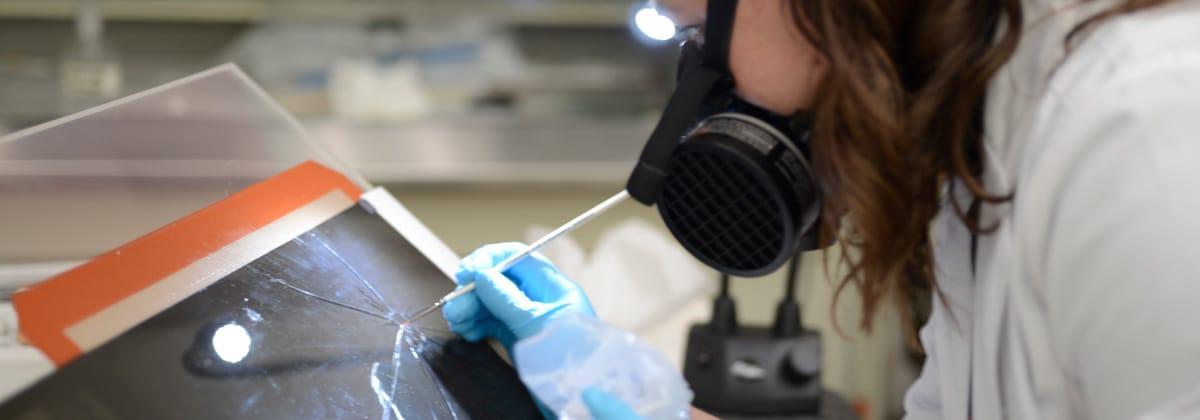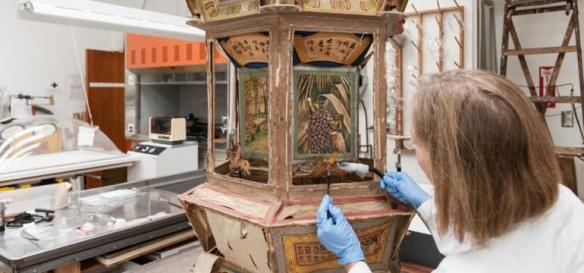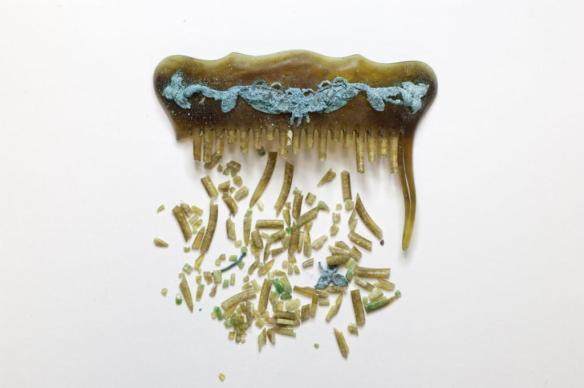
Modernization
Learn more about government’s intention to modernize the museum to protect our historic holdings and provide better access to our collections.

Conservation is responsible for the care and preservation of the Royal BC Museum collections. We monitor the relative humidity, temperature, lighting and air quality to ensure that artifacts and specimens are protected from deterioration.
Our conservators lend expertise across disciplines, providing such services as materials analysis, exhibit planning and public programs and events coordination as they relate to collections. We record the condition of collections for acquisition, loans, exhibits and deaccession and perform professional conservation treatments when necessary. Conservation staff are also responsible for responding to disasters by planning emergency preparedness procedures and supplies, organizing collection recovery and collections salvage efforts.

Within Canadian society, the traditional definition of “conservation” has focused on the examination, analysis and treatment of cultural heritage objects (specimens, artifacts and archival records) to ensure that they are kept in a condition as close to their original state as possible so that future generations can learn from and enjoy our heritage.
Today, the definition of conservation has broadened to include a stronger stewardship role. There is a strong ethical component to today’s conservation which involves minimal intervention, full documentation of efforts taken, and consideration of the views of the stakeholders and the cultural context of the object.
There are two main streams of conservation activity:
Preventive conservation is the creation and maintenance of a protective environment for the cultural heritage objects in our care. Elements needing control would include temperature, humidity, light, pollutants and physical support, among others.
Interventive conservation refers to the direct involvement of a conservator with the object. Such actions might include cleaning, repair, consolidation of fragile surfaces, filling and in-painting of losses and so on. It is of paramount importance that the conservator’s work is documented and reversible, as dictated by his/her professional code of ethics, so there is no doubt about what constitutes the original object and what has been done to alter it.

Conservation ensures that all appropriate measures are taken to preserve the collections of the Royal British Columbia Museum. Optimum preservation conditions, policies and procedures are developed and maintained for all collections, including those on permanent exhibit, traveling exhibitions, storage or on loan.
The Royal BC Museum conservators all have formal university degrees in the conservation of museum and archival collections. They provide advice, expertise and practical skills to undertake conservation treatment and analysis. Curators, collections managers, archivists and archival technicians, exhibit designers and exhibit arts technicians also provide preventive conservation support to the Royal BC Museum collections.
Specifically, preventive conservation at the Royal BC Museum includes the following activities:
In addition to preventive conservation, Conservation provides highly specialized condition assessment, analysis and treatment of collections. Condition assessments are carried out on all new acquisitions, prior to, during and after loans and exhibitions of objects, and any time an object undergoes conservation treatment. Condition reports involve a detailed examination of the materials and manufacturing techniques of the objects, including photo documentation to track changes over time.
Conservation treatments are carried out to stabilize the condition of objects when they are actively deteriorating. An example of this would be a traditional basket that has collapsed inward and requires humidification to make it pliable enough to reshape before a custom-made internal support is fashioned. Collections may require conservation treatment in preparation for exhibit or loan. Even if the object is physically and chemically stable, it may need to be cleaned to improve its appearance or paint losses may need to be toned in so that the original appearance of an artifact can be better understood or an artwork is more aesthetically pleasing. Often these types of treatments are not necessary when collections are in storage, but are only required for better interpretation of the object while on exhibit. Rarely is an object restored to an original, pristine condition, as the history of use is important to its interpretation. Everything that conservators do to an object should be reversible, in case better techniques are developed in the future, or information comes to light that makes the treatment less desirable.
Conservators are also scientists, using microscopes, spot tests and basic analytical equipment to identify the nature of materials or the processes of deterioration. In the three Royal BC Museum conservation laboratories, plastics can be identified to separate those that are sure to deteriorate quickly, such as cellulose nitrate film. Pesticide residues can be detected to ensure health and safety around natural history specimens. Textile fibres and pigments are analyzed by microscopy to assist the curators in determining their identity and even their source or maker.
The activities of Conservation are not confined to the existing collections, but rather our conservators play an active role in collection acquisition and in the broader collections development. From assessing the condition of potential acquisitions or donations to studying the deterioration of new 3D printer plastics to documenting environmental needs for future storage, our conservators play an active and necessary role in the daily life of the Royal BC Museum.